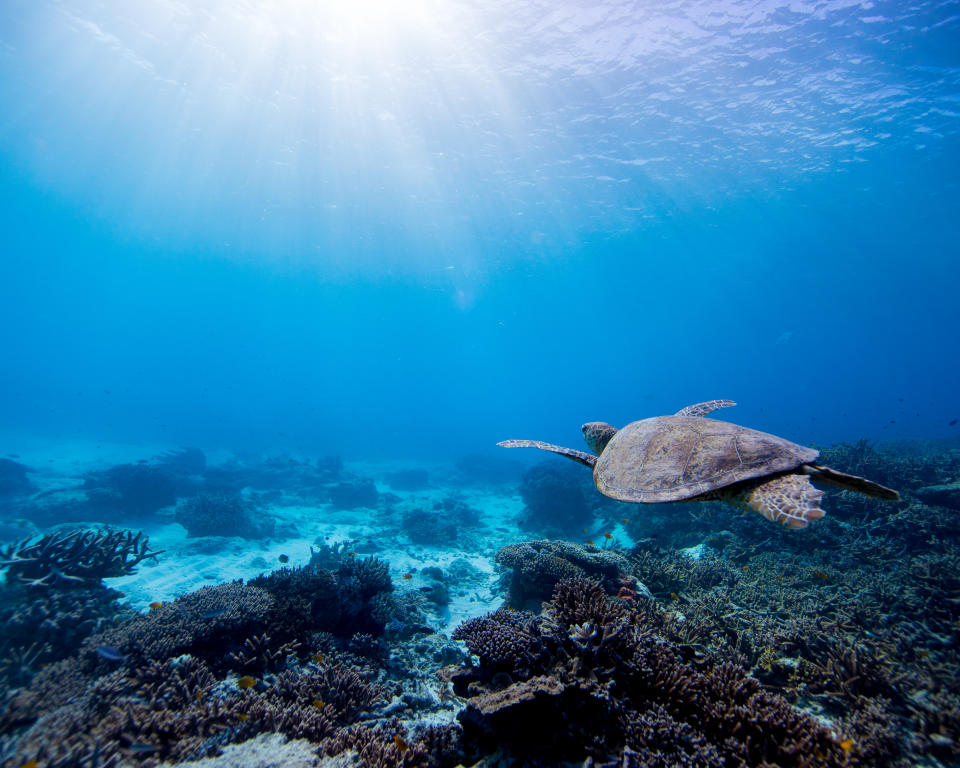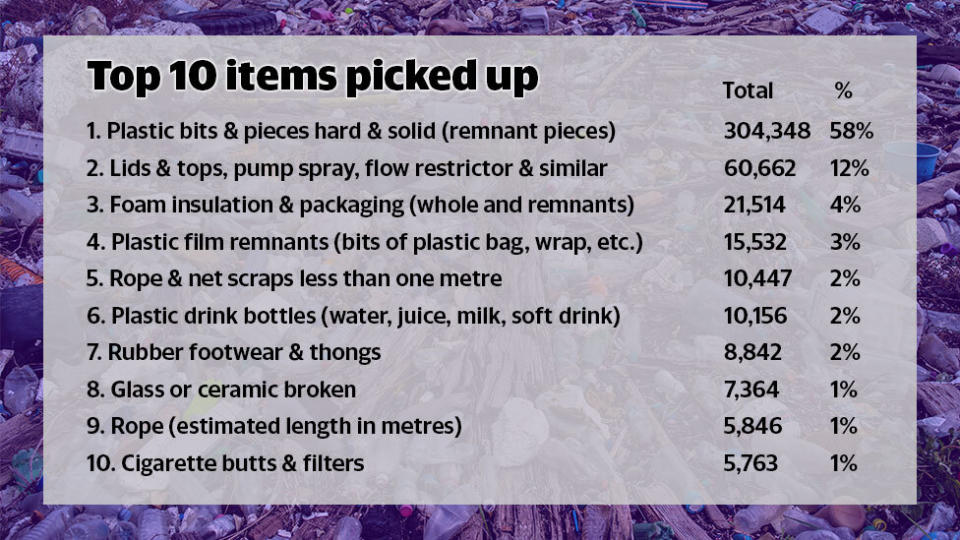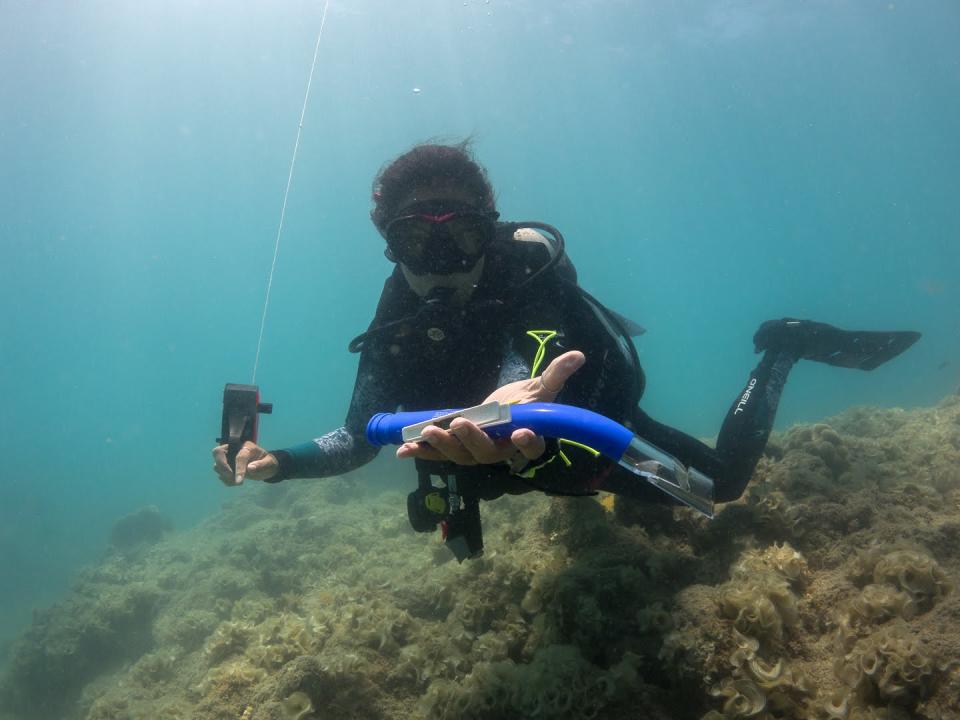The surprising items found in huge rubbish haul from Great Barrier Reef
New figures shed light on the makeup of more than 24-tonnes of garbage, hauled from an area surrounding one of Australia’s most renowned tourist attractions.
Thousands of household plastics including toothbrushes and lighters were removed from areas around the Great Barrier Reef last year as part of the federal government’s ReefClean program.
Over 8,842 thongs, 10,156 drink bottles were removed from beaches, including seven beaches across the remote the Cape York Peninsula.
Broken pieces of plastic were the most commonly found item, with a startling 304,348 picked up across the area.
The other nine items making up the top 10 were plastic lids, foam insulation, plastic film remnants, short lengths of rope, drink bottles, rubber footware, glass and ceramics, long lengths of rope, and cigarette butts.

The program ran 49 community clean-up activities and regularly monitored 33 beaches, resulting in a clear understanding of the items most affecting our beaches.
With the world’s human population growing, so too is our seemingly insurmountable load of garbage that’s flowing into the ocean.
The $5 million ReefClean program aims to combat the problem by tracing the litter back to its source, so analysts can work towards prevention.

Tangaroa Blue Foundation’s CEO Heidi Taylor, who worked in partnership on the program, told Yahoo News Australia that each piece of rubbish is systematically categorised and weighed.
This, she believes, makes volunteers feel like “part of the solution rather than just a rubbish collector”.
“If all you do is clean up that’s all you’re ever going to do,” Ms Taylor said.
“Eventually you get to the point where you’d say it’s a waste of time because I can come back tomorrow, or next week, or next month and I’d have to do the same thing, but because we collect data on everything we pick up and that data is used to actually inform change.
“When volunteers are able to get a major change done they can see that by not seeing a particular item ending up on the beach any more.”

Rethinking the pool noodle to help save our oceans
Environment minister Sussan Ley said the report highlighted the importance of managing our own waste and the need to recycle responsibly.
“Plastic and other debris in our oceans pose a huge threat to marine and bird life and it remains a priority area for the Morrison Government,” she said in a statement.
The longer plastic is in the environment, the more it fragments into smaller pieces, making it harder to collect.
Ms Taylor expects it will take decades for the amount of plastic in the ocean to be reduced, but by targeting particular items and changing the policies, fewer new items could end up in our waterways.
One particular area of focus is non-essential items that go on to have a major impact on the environment.

“You know those pool noodles that people put under their arms as they go swimming around?” she said.
“The amount of those that we find in Cape York that have been lost from charter boat operators on the Great Barrier Reef and have floated all the way up is actually quite surprising.”
She believes that every item that ends up in the ocean is there because of a design flaw, which could be the product being too cheap, or not fit for purpose. An example again is the pool noodle.
“There are a lot of other materials that make things float,” she said.
“The fact that we make (pool noodles) out of a foam type material that has less than six months life if it’s sitting out there in the sun before it disintegrates into a gazillion pieces of micro plastic, and we take it out into the Great Barrier Reef, which we’re trying to protect, is based on one thing and that’s the cost of the item.
“At the moment society is so focused on everything being cheap, and convenient, and easy, well when we look at the amount of litter in our environment, that’s a consequence of that decision.”
How a cyclone off Vanuatu impacts Australia
As part of the program, volunteers have visited remote beaches which look to have never been cleaned before.
Program coordinators are currently unable to visit some of the worst affected areas which are currently closed off to protect vulnerable Indigenous communities from the coronavirus.
Across remote parts of Cape York, an average 1863 pieces of garbage were removed from each hectare of coastline visited by the volunteers.

In these areas, the data collected suggests 90 per cent of the garbage originates from foreign waters.
Analysis of trade winds and ocean currents has mapped how the garbage travels to Australia from shipping operators and overseas nations.
Once plastic and fishing nets arrive in sensitive marine environments, it is a serious threat to turtles, dugongs, dolphins, and seabirds as well as coral reefs.
'Can't sleep at night': Controversial 'deadly' fence dividing opinion on 'wild dogs'
The battle to save Australia's dying koalas continues amid coronavirus crisis
Tragic story behind circles of bones photographed in city street
According to Ms Taylor, unexpected weather events can take clean up programs back to square one.
“Occasionally you go to a place and you think, ‘wow we’ve got on top of the debris loads now’… and then all of a sudden, there’s a cyclone off Vanuatu and you’ve got four times the debris you thought you were going to have,” she said.
“Those surprise loads that just pop out are always shocking and a bit disheartening.”
Do you have a story tip? Email: newsroomau@yahoonews.com.
You can also follow us on Facebook, Instagram and Twitter and download the Yahoo News app from the App Store or Google Play.




